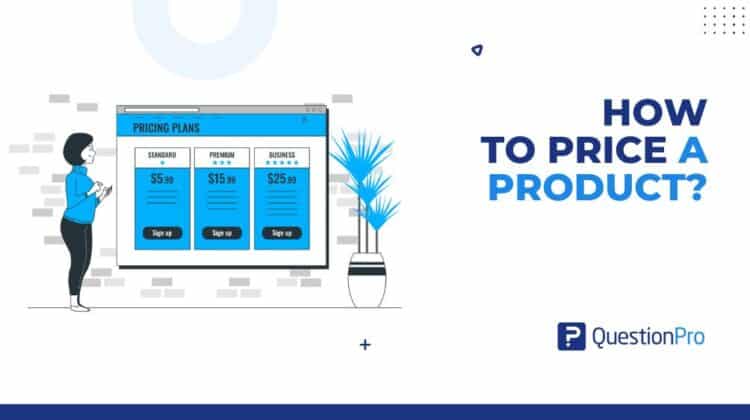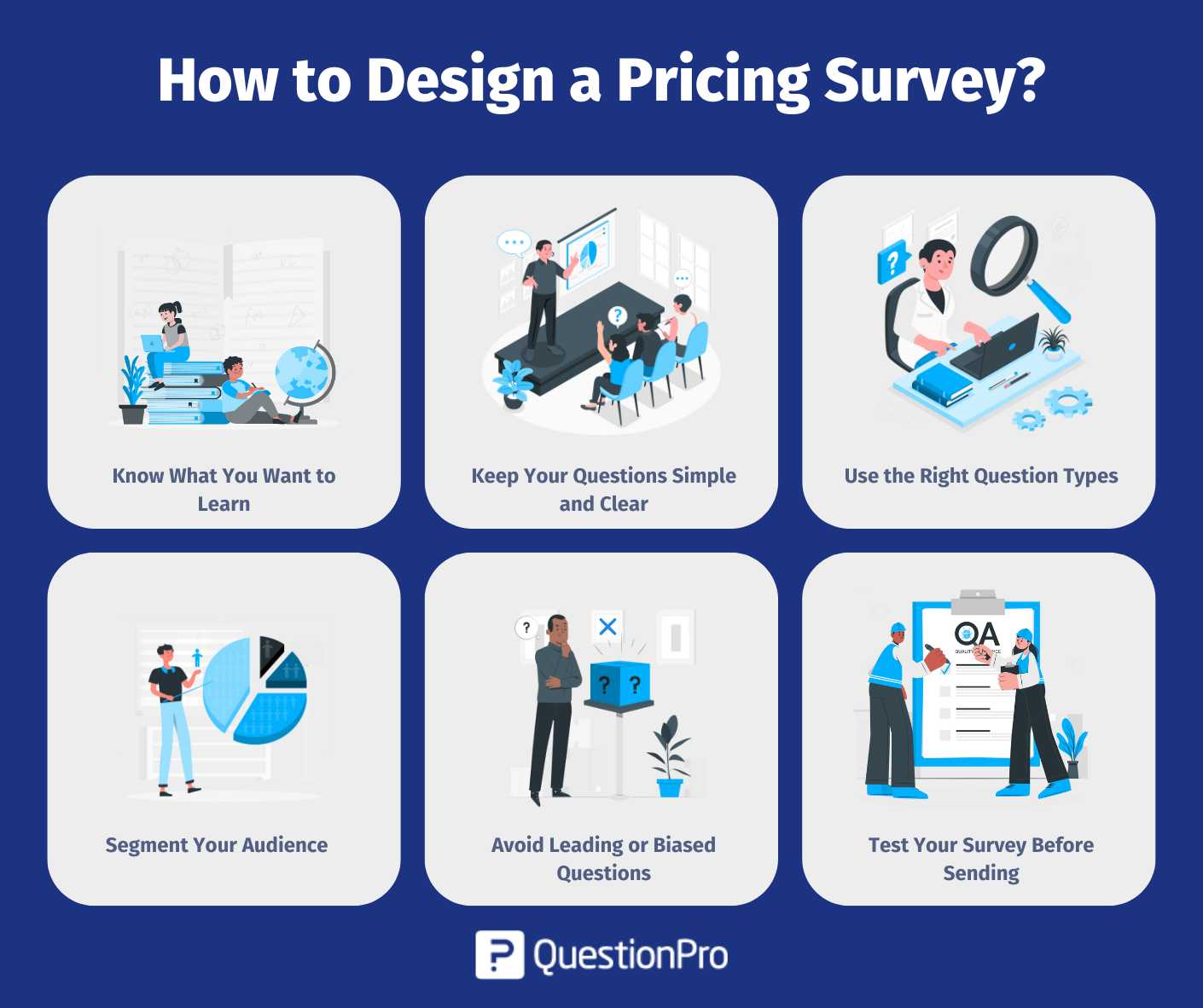
Figuring out how to price a product can feel like walking a tightrope. Too high, and you risk losing customers. Too low, and you might miss out on profits or even devalue your brand. But what if you didn’t have to guess? What if you could rely on real insights from your target audience to find the perfect price?
Getting the price right isn’t just about covering costs; it’s also about understanding how your customers perceive value. By considering production costs, competitor pricing, and what your customers are actually willing to pay, you can set a final price that feels fair to them and profitable for your business.
In this blog, we’ll walk you through everything you need to know about product pricing, from understanding what product pricing really means, calculating costs, adding a profit margin, to designing effective pricing surveys. By the end, you’ll have the know-how to set prices that delight your customers and boost your profits.
What is Product Pricing?
Product pricing is the process of determining the amount a customer will pay for your product. It’s more than simply adding a markup to your costs; it’s about understanding the value your product brings, the needs of your target audience, and the conditions of the market you’re selling in.
When you price a product, you’re making a strategic decision that can influence how customers perceive it, how competitive you are, and how profitable your business will be. A well-thought-out price takes into account your production costs, competitor pricing, market trends, market conditions, and, most importantly, how much your customers are willing to pay.
The right pricing can position your product as affordable, premium, or somewhere in between. It can encourage customers to choose you over competitors or even shape their expectations about quality. In short, product pricing is the meeting point between business strategy, customer psychology, and market realities. Choosing the right pricing model is also a key part of product pricing, as it determines how you structure and present your prices to customers. When done right, it not only drives sales but also strengthens your brand in the long run.
Why is Pricing Research Necessary?
When you’re figuring out how to price a product, guessing can be risky. Pricing research is like having a clear map before setting out on a journey.
It helps you avoid costly mistakes and gives you confidence in your decisions. Instead of relying only on gut feelings, you get real insights into what your customers are willing to pay and how your pricing stacks up against competitors.
Here’s why it matters:
- Clear direction: You understand the best price range that fits both your market and your customers.
- Better profits: Even a small price change—just 1-2%—can boost profits by 10-20%.
- Customer loyalty: Matching your price with customer expectations builds trust and repeat business.
- Competitive pricing edge: You know where you stand in the market and how to position yourself to win.
How to Price Your Product Effectively?
Setting the right price for your product can seem complex, but with a clear strategy, it becomes much easier. The goal is to cover all your costs while earning a healthy profit. Here’s a simple step-by-step process to help you calculate the right selling price.
- Calculate Fixed Costs
List expenses that stay the same no matter how much you sell, like rent, salaries, insurance, or equipment. These overhead costs form your pricing foundation.
- Calculate Variable Costs
Add up costs that change with production, such as materials, packaging, shipping, and labor. For example, if materials cost $3 and packaging $2, your variable cost per unit is $5.
- Include Extra Costs
If you sell internationally, factor in tariffs, customs fees, and higher shipping costs. Ignoring them can cut into your profit margins.
- Find Your Cost per Unit
Use this formula to calculate the real cost of each product:
Cost per unit = (Fixed costs + Variable costs) ÷ Units produced
Example: If total costs are $3,000 and you make 500 units, your cost per product is $6. From there, add your desired profit margin to set the selling price.
- Set the Final Price
Once you know your unit cost, research competitor pricing and customer expectations. Adjust your price to stay profitable while remaining attractive to buyers.
Smart Pricing Strategies for Your Business
Choosing the right pricing strategy is a crucial step for any business owner looking to maximize profit margins and stay ahead in a competitive market. A well-crafted pricing strategy not only determines how much you charge for your products or services but also shapes how customers perceive your brand and influences your overall revenue.
There are several common pricing strategies that businesses can use, each with its own advantages and best-use scenarios:
- Cost plus pricing: This straightforward approach involves calculating all the costs involved in producing your product or service, then adding a set profit margin on top. It’s simple and ensures you cover your expenses, but it may not always reflect what customers are willing to pay.
- Competitive pricing: Here, you set your prices based on what your competitors are charging for similar products or services. This strategy is especially useful in markets where prices are transparent and customers can easily compare options.
- Value-based pricing: This strategy focuses on the perceived value your product or service offers to customers, rather than just the cost to produce it. If your offering provides unique benefits or solves a specific problem, you can often command a higher price.
- Dynamic pricing: With dynamic pricing, your prices change in response to market demand, seasonality, or even customer behavior. This approach is common in industries like travel, hospitality, and software companies, where demand can fluctuate rapidly.
Selecting the right pricing strategy depends on your business goals, the nature of your products or services, your target customers, and the competitive landscape. By understanding and applying different pricing strategies, you can find the optimal price point that boosts your profit margins and supports long-term growth.
How to Design a Pricing Survey?
Designing a pricing survey might sound complicated, but it doesn’t have to be. Think of it as having a conversation with your customers to understand what they’re willing to pay. Here’s how you can do it in a simple, step-by-step way.

1. Know What You Want to Learn
Before you write any questions, be clear about your goal. Are you trying to find the ideal price range for a new product? Or are you testing how customers feel about your current prices? Knowing what you want will make your survey focused and useful.
Keep Your Questions Simple and Clear
Avoid complicated language or technical terms. Ask questions that your customers can answer quickly and easily. For example, instead of asking, “What is your perceived value of this product in relation to market alternatives?” just ask, “How much would you pay for this product?”
Use the Right Question Types
There are a few ways to ask about price:
- Multiple choice: Give a range of prices and let customers pick one.
“Which of the following prices would you be willing to pay for this product?- $10
- $15
- $20
- $25
- Open-ended: Let them type the exact price they’d pay.
“What price would you be willing to pay for this product?”
- Price sensitivity scales: Ask at what price they think the product is too cheap, expensive, or just right.
“At what price would you consider this product too expensive?- Too cheap
- Just right
- Conjoint Analysis: Helps you understand how customers value different features and what combination of features and price they prefer.
“Would you prefer Product A with Feature X at $20 or Product B with Feature Y at $25?” - Gabor-Granger Price Sensitivity: Measures the likelihood of purchase at different price points to find the optimal price.
“How likely are you to buy this product if it costs $15, $20, $25, or $30?”
- Price Rating Scales: Customers rate whether a price is cheap, expensive, or reasonable, giving a clear picture of perceived value.
“Please rate this price: $20- Very Cheap
- Cheap
- Fair
- Expensive
- Very Expensive
- Van Westendorp Pricing Studies: Identifies acceptable price ranges by asking customers at which price points a product is too expensive, too cheap, or just right.
At what price would you consider this product?- Too expensive
- Too cheap
- Expensive but acceptable
- Ideal price
4. Segment Your Audience
Not all customers are the same. Try to gather demographic info like age, location, or buying habits so you can see how different groups respond. This helps you set a price that works for your target market, not just the average customer.
Avoid Leading or Biased Questions
When designing your pricing survey, it’s really important to ask questions in a way that doesn’t push your customers toward a certain answer. If your questions are leading or biased, the feedback you get won’t reflect what people truly think, and that can give you misleading results.
For example, instead of asking, “Don’t you think this product is worth $50?”, you should ask, “What price would you be willing to pay for this product?”
Also, avoid using words that suggest a “right” answer, like “cheap,” “expensive,” or “best value.” Keep your questions neutral and clear so that customers can answer honestly.
The goal is to hear their real opinions, not the answers they think you want to hear. This ensures your pricing decisions are based on accurate, reliable data.
6. Test Your Survey Before Sending
Before you send your pricing survey to all your customers, it’s a good idea to test it first. Testing helps you catch problems early and ensures your survey collects useful data. Here’s what to do:
- Try it on a small group: Pick a few people who represent your target audience.
- Check for clarity: Make sure the questions are easy to understand and not confusing.
- Look for technical issues: Ensure all links, scales, and response options work properly.
- Ask for feedback: See if any part feels awkward or takes too long to complete.
By taking the time to test your survey, you make sure it runs smoothly and your results reflect what your customers really think. This small step can save you a lot of trouble later and give you more reliable insights for pricing your product.
Common Mistakes in Pricing Surveys
Pricing surveys can give you super valuable insights, but only if you do them right. There are a few common mistakes people often make that can mess up the results. Here’s what to watch out for:
- Asking unclear or confusing questions: If your questions are confusing, customers might guess or skip them. Keep your language simple and clear for honest answers.
- Leading or biased questions: Avoid wording that pushes respondents toward a particular answer.
- Surveying the wrong audience: Not everyone is your ideal customer. Make sure you’re sending the survey to people who actually fit your target market.
- Relying on one-time surveys only: Customer preferences can change over time. If you only run a pricing survey once, you might miss shifts in demand or perception. It’s a good idea to check in periodically and update your pricing insights.
How QuestionPro Helps You Price a Product Right?
Pricing your product can feel overwhelming, especially when you want to find the sweet spot that customers love and your business can profit from. QuestionPro makes the whole process much easier, giving you the tools to collect real feedback and make smart pricing decisions.
1. Customize Your Survey to Fit Your Needs
With QuestionPro, you can design surveys that match exactly what you want to learn.
It’s not just about asking questions; it’s about asking the right people. QuestionPro gives you access to a targeted panel of respondents that match your ideal customer profile. That means the data you collect reflects the opinions of people who are actually likely to buy your product, rather than random or irrelevant responses.
Want to know if customers are willing to pay $20 or $30? Or which features they value most and would pay extra for? You can create multiple-choice questions, rating scales, or open-ended questions to get the most detailed insights.
This customization ensures you’re not guessing you’re getting answers straight from the people who matter.
2. Reach the Right Audience
It’s not just about asking questions; it’s about asking the right people. QuestionPro gives you access to a targeted panel of respondents that match your ideal customer profile. That means the data you collect reflects the opinions of people who are actually likely to buy your product, rather than random or irrelevant responses.
3. Advanced Analysis
Collecting survey responses is only part of the story. QuestionPro makes it easy to analyze your results with powerful tools.
You can see trends in customer price preferences, compare responses across different groups, and even use sentiment analysis to understand how people feel about your pricing. All of this helps you make decisions that are backed by data, not guesswork.
4. Make Surveys Easy to Complete
Making your survey simple and user-friendly is key to getting honest and useful feedback. If it’s complicated or hard to navigate, people might abandon it or rush through without thinking.
- Mobile-friendly: Customers can respond on phones, tablets, or computers.
- Clear design: Keep questions easy to read and answer quickly.
- Short and focused: Avoid making surveys too long, stick to what’s important.
- Simple instructions: Let participants know exactly what to do at each step.
When your survey is easy to complete, more people will participate, and the responses will be more accurate. This means you get better data, which helps you make smarter pricing decisions for your product.
5. Integrate with Your Other Tools
QuestionPro doesn’t work in isolation. It integrates with popular tools like Salesforce, Google Analytics, and Mailchimp, making it simple to combine survey insights with your existing business data. This means you can see the full picture and use your survey findings to shape your overall pricing strategy effectively.
Using QuestionPro, you’re not just guessing what price might work. You’re listening to your customers, analyzing real data, and confidently setting a price that balances value for them and profit for you. It turns a stressful decision into a clear, data-driven strategy.
Recommended Read: Pricing Analytics Software to Optimize Your Pricing Strategy
Conclusion
Figuring out how to price a product isn’t just a numbers game; it’s a strategic decision that affects your sales, brand perception, and profitability. By understanding your fixed and variable costs, considering international expenses, calculating cost per unit, and adding the right profit margin, you can set a price that works for both your business and your customers.
Designing a thoughtful pricing survey helps you gather real feedback from your target audience, avoid common mistakes, and make informed decisions rather than relying on guesswork. When you combine careful cost analysis with customer insights, you create a pricing strategy that is fair, competitive, and profitable.
At the end of the day, getting your pricing right is about balancing value for your customers with growth for your business. Follow these steps, and you’ll have the confidence to set prices that not only attract buyers but also strengthen your brand and maximize your profits.
Tools like QuestionPro can make this process much easier. With customizable surveys, access to targeted respondents, and powerful analysis features, you can collect reliable customer feedback, understand price preferences, and make data-driven decisions with confidence.
Frequently Asked Questions (FAQs)
Answer: To calculate your product cost, add up your fixed costs (like rent and salaries) and variable costs (like materials and packaging), then divide by the number of units you produce.
Answer: A profit margin is the percentage of profit you want to earn on top of your costs. Multiply your cost per unit by (1 + desired margin) to set your selling price.
Answer: Pricing surveys collect feedback directly from your target audience, helping you understand what customers are willing to pay and avoid guessing.
Answer: Avoid unclear or biased questions, surveying the wrong audience, and relying on one-time surveys only. These mistakes can lead to inaccurate or misleading data.
Answer: Yes, tools like QuestionPro let you create targeted surveys, analyze results, and gain actionable insights, making pricing decisions data-driven and reliable.







